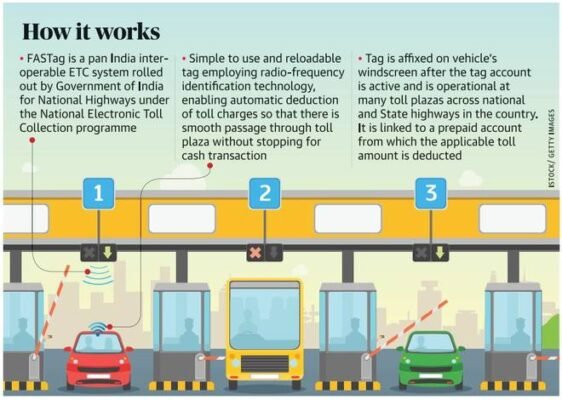GS P6 (Economy, Geography, Environment...), Science & Technology, Technology, UPSC
Q.6. What is the technology being employed for electronic toll collection on highways? What are its advantages and limitations? What are the proposed changes that will make this process seamless? Would this transition carry any potential hazards? [UPSC 2024 GS P-3]
Technology for Electronic Toll Collection on Highways
The technology primarily used for Electronic Toll Collection (ETC) on highways is Radio Frequency Identification (RFID) through systems like FASTag in India and E-ZPass in the US. This system allows vehicles to pass through toll plazas without stopping by using an RFID tag affixed to the vehicle’s windshield. As the vehicle passes through the toll gate, RFID readers scan the tag, which is linked to a prepaid account, automatically deducting the toll amount.
How it Works:
- RFID Tag: The vehicle is equipped with a passive RFID tag containing a unique identification code.
- RFID Reader: Toll plazas are equipped with RFID readers that automatically read the tag as the vehicle approaches.
- Centralized System: The reader communicates with a backend system that deducts the toll amount from the vehicle’s linked account.
Advantages of Electronic Toll Collection
- Reduced Congestion:
- Vehicles no longer need to stop at toll booths, significantly reducing traffic congestion at toll plazas.
- ETC ensures faster transit, reducing travel time for commuters.
- Convenience:
- Drivers do not need to carry cash, ensuring a smoother toll-paying experience.
- The system operates 24/7, with no need for human interaction, thus making it more efficient.
- Fuel Savings:
- Continuous vehicle movement reduces idling time, leading to lower fuel consumption and reduced emissions, contributing to environmental sustainability.
- Revenue Collection Transparency:
- ETC reduces the potential for human errors or corruption, as toll amounts are automatically deducted.
- It improves revenue collection for road authorities by minimizing toll evasion.
- Data Analytics:
- The system generates valuable data about traffic patterns, which can be used for planning and infrastructure improvements.
Limitations of the Current System
- Intermittent Technical Failures:
- RFID readers can malfunction due to hardware issues, environmental conditions (e.g., rain, dust), or tag errors, leading to delays.
- Some RFID tags may not be detected properly, requiring manual intervention.
- Non-Standardized Technology:
- Different toll operators may use varying technologies, causing incompatibility for users traveling across regions. For example, some users may need to purchase multiple tags for different highways.
- Limited Coverage:
- ETC is not yet fully implemented across all highways, meaning some toll plazas still require manual cash transactions, limiting the system’s seamless operation.
- Cost of Implementation:
- Setting up RFID systems at toll plazas, integrating them with a centralized payment system, and maintaining the infrastructure require substantial investment.
- Tag Availability and User Compliance:
- Some drivers fail to install RFID tags or keep their accounts adequately funded, leading to enforcement challenges and traffic delays.
Proposed Changes for Seamless ETC
- GPS-Based Tolling:
- The next generation of ETC is likely to move towards GPS-based toll collection. Vehicles will be equipped with GPS systems that track their movement on toll roads and automatically calculate and deduct tolls based on distance traveled.
- This system will eliminate the need for toll booths altogether, allowing truly seamless travel across toll highways.
- Interoperability:
- Proposals for standardizing technologies across different tolling systems and regions are being considered to ensure that a single system works on all highways, simplifying the user experience.
- Better Integration with Banking and Payment Systems:
- Integrating ETC systems more tightly with digital payment platforms such as UPI (Unified Payments Interface), credit cards, and mobile wallets would ensure smoother transactions and better compliance.
- Enhanced Automation and AI:
- The use of AI-based traffic monitoring and predictive algorithms can further streamline the toll collection process, reducing errors and ensuring that even vehicles without RFID tags can be detected and charged appropriately.
Potential Hazards of the Transition
- Data Privacy and Security Concerns:
- The shift to GPS-based tolling or more advanced RFID systems will involve tracking vehicle movements, raising concerns about privacy and data misuse.
- There is a risk of cybersecurity breaches, which could lead to unauthorized access to personal or financial information linked to the toll accounts.
- Job Losses:
- As ETC systems become more automated, there is a risk of job loss for toll booth operators and associated personnel, potentially impacting employment.
- Technical and Infrastructure Challenges:
- The transition to a GPS-based toll system will require significant infrastructure upgrades, including satellite-based systems, which may be expensive and prone to initial operational challenges.
- Poor GPS signal coverage in certain areas (e.g., tunnels, remote regions) may disrupt accurate toll collection.
- Resistance to Adoption:
- Drivers may be reluctant to adopt the new technology due to the cost of upgrading their vehicles, and non-tech-savvy users may face difficulties in adapting to a fully digital tolling system.
- Increased Surveillance Concerns:
- A GPS-based system could lead to concerns about government surveillance of citizen movements, especially in regions where data protection laws are weak or ambiguous.
Conclusion
The technology employed for electronic toll collection, primarily RFID, has numerous advantages such as reducing congestion, saving fuel, and improving efficiency. However, limitations like technical glitches, limited coverage, and costs persist. The proposed shift to GPS-based tolling offers a more seamless experience, but it comes with potential hazards such as privacy concerns, job displacement, and significant infrastructure investments. These challenges need to be addressed carefully to ensure a smooth and safe transition to the next generation of tolling systems.


